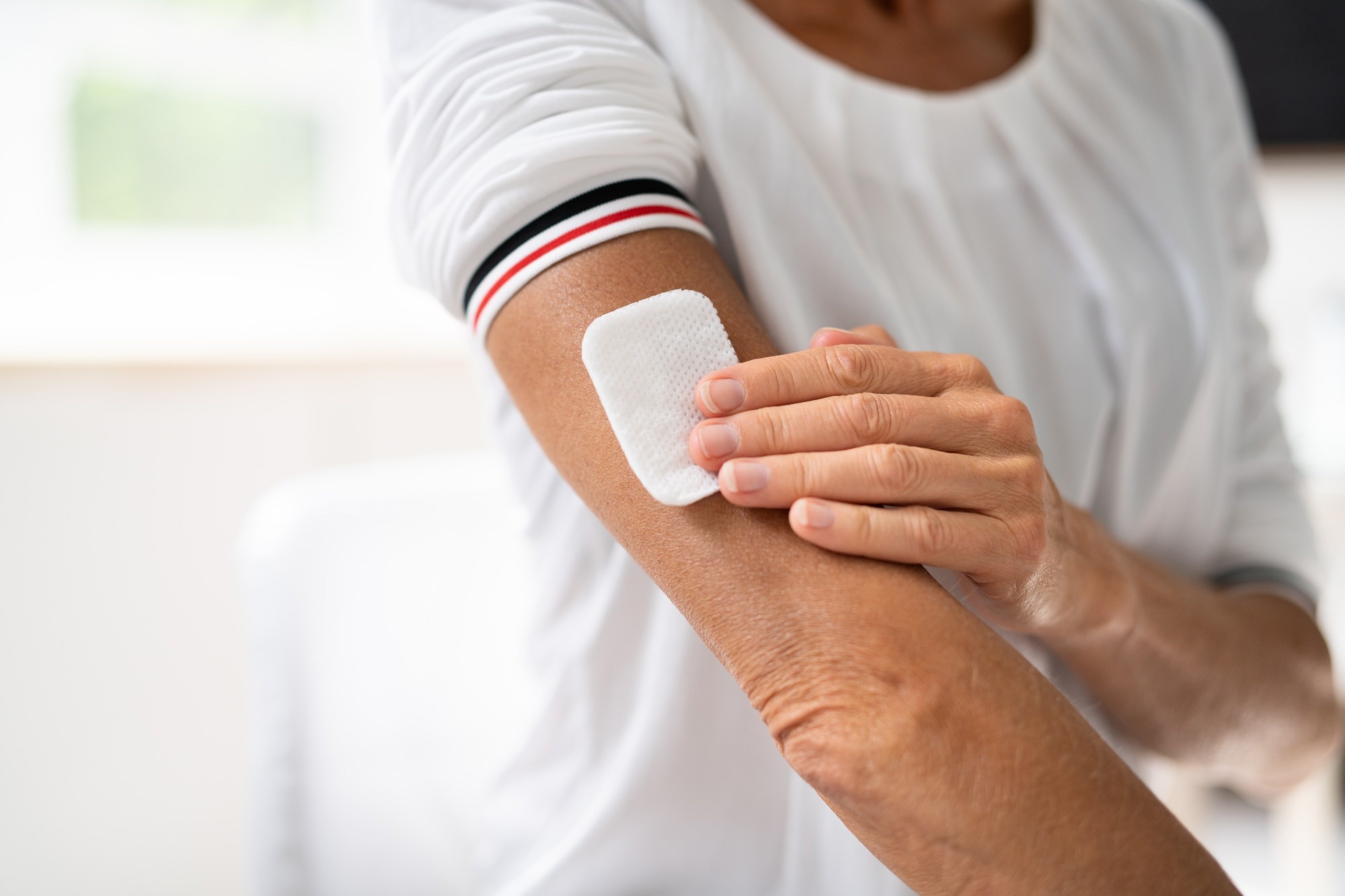Scientists have developed an electrically activated patch with biocompatible metallic membranes and microneedles, enabling precise, repeated, personalized, and safe drug delivery.
 Study: Digital automation of transdermal drug delivery with high spatiotemporal resolution. Image Credit: Andrey_Popov/Shutterstock.com
Study: Digital automation of transdermal drug delivery with high spatiotemporal resolution. Image Credit: Andrey_Popov/Shutterstock.com
Background
Although transdermal drug delivery through hypodermic needles is a rapid, low-cost, safe, and relatively painless process of delivering pharmaceutical products such as vaccines and biotherapeutics, the use of this procedure for chronic diseases that require long-term management and repetitive treatments continues to present significant challenges, especially related to patient compliance.
Hypodermic needles also raise concerns about safe disposal and dangers of bloodborne pathogen transmission, apart from the fact that widespread use of this method requires trained personnel.
Strategies for transdermal drug delivery that have been explored recently include sonophoresis or the use of ultrasound in delivering drugs through the skin; iontophoresis, which uses weak electric currents for transdermal delivery of drugs, heat, electroporation, microneedles, and the use of photomechanical waves.
While some of these methods have significantly improved certain aspects of drug delivery, such as ease of use and painless drug delivery, a method of transdermal drug delivery that can be used for chronic diseases requiring coordinated and precise delivery of drugs for extended periods is not in clinical use.
About the study
In the present study, the researchers used electrical external triggers combined with a biocompatible metallic membrane that can carry drug-containing microneedles to develop the transdermal drug delivery patch called the spatiotemporal on-demand patch or SOP.
Microneedles have been tested and used for various applications, such as the delivery of nanocomposites, peptides, nucleic acids, small molecules, and other types of pharmaceuticals.
Furthermore, the chemical functionality of microneedles can be modulated by altering their structural integrity, providing a wide variety of release profiles.
Microneedles that have a core-shell structure containing a drug reservoir can be pre-programmed to release the drug at the right time by tuning the degradability of the core-shell. Multiple drugs can also be loaded into these microneedles for step-wise drug delivery during combined therapy.
However, complex fabrication methods pose challenges to the scalability of such methods, and the pre-programmed microneedles cannot be changed once deployed.
On the other hand, through chemical functionalization, microneedles can be programmed to release the biotherapeutics through self-regulation and self-sensing.
For example, materials such as aminoimidazole and phenylboronic acid have been used for constructing microneedles that react to body glucose and undergo structural changes to release insulin.
External triggers such as electric impulses have also been utilized to control the active delivery of drugs, and this technology, when combined with health monitors, provides a closed-loop therapy system.
The integration of metallic gates made of thin biocompatible metal membranes has improved the active control of drug delivery using microneedles.
Magnesium, molybdenum, and gold are some of the metals used to form these gates, and the use of electric impulses to trigger the corrosive or oxidative opening of these gates can be used to release the drugs on demand actively.
Results
The results reported that the SOP was constructed using an approximately 150-nanometer thin layer of gold that was coated onto the microneedles to encapsulate and protect the drugs during the standby stage.
Furthermore, electrical impulses were used to trigger these gated microneedles to release the drugs on demand, making the SOP highly spatiotemporally controllable.
The gold coating in these gated microneedles can be disintegrated by applying a direct current of approximately 2.5 volts for 30 seconds, initiating drug delivery.
A wireless communication method using low-energy Bluetooth and near-field communication integrated into the SOP through microfabrication also allows individual microneedles or subsections of the patch to be activated for drug release.
Furthermore, each microneedle has a spatial control of less than one square millimeter, which, combined with a 30-second temporal aspect to the drug release, allows ultrafine spatiotemporal control.
In vivo experiments using mice models also showed that the use of SOP in releasing exogenous melatonin resulted in sleep improvements, highlighting the use of SOP for clinical treatments and neurological research in animal models.
Furthermore, successful intracranial SOP implantation experiments in mice indicated its potential use in sequentially delivering drugs to specific brain regions for treating neurological disorders.
Conclusions
To summarize, the study reported the development of a transdermal drug delivery system that combines biocompatible metal-gated microneedles with wireless communication and electrical triggering systems to precisely and actively deliver drugs through the skin.
The fully automated aspect of the system is expected to improve treatment adherence.
Journal reference:
-
Wang, Y., Chen, Z., Davis, B., Lipman, W., Xing, S., Zhang, L., Wang, T., Hafiz, P., Xie, W., Yan, Z., Huang, Z., Song, J., & Bai, W. (2024). Digital automation of transdermal drug delivery with high spatiotemporal resolution. Nature Communications, 15(1), 511. doi: https://doi.org/10.1038/s41467023445320